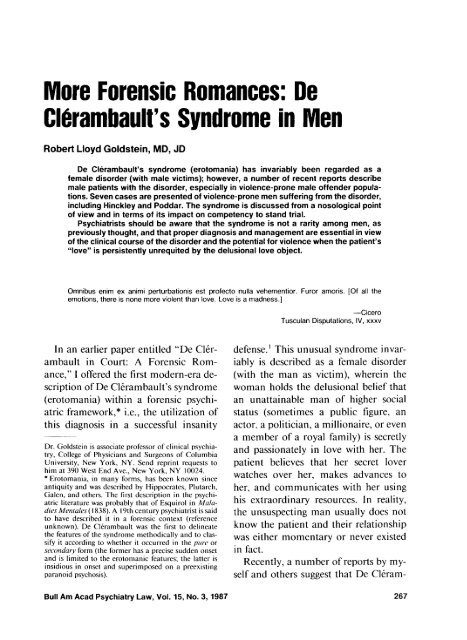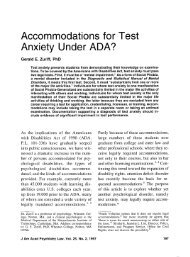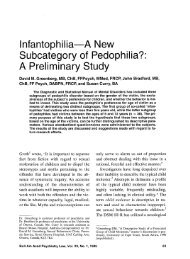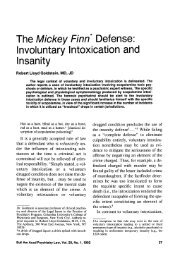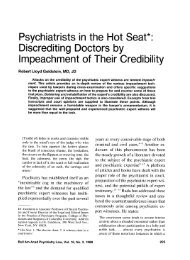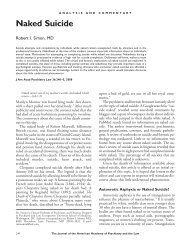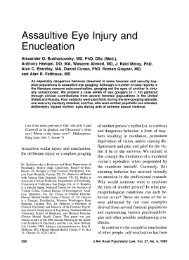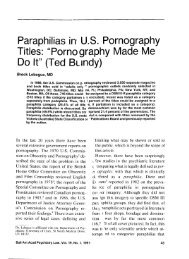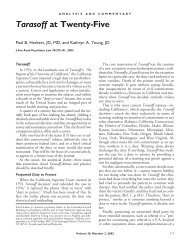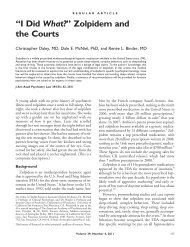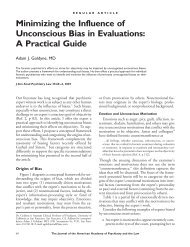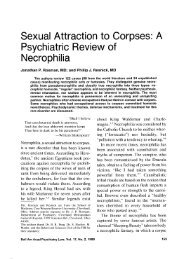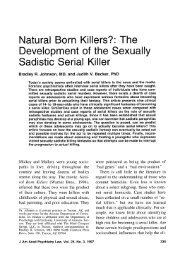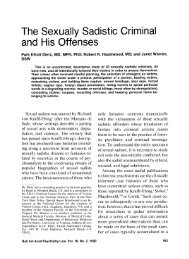More Forensic Romances: De - Journal of the American Academy of ...
More Forensic Romances: De - Journal of the American Academy of ...
More Forensic Romances: De - Journal of the American Academy of ...
Create successful ePaper yourself
Turn your PDF publications into a flip-book with our unique Google optimized e-Paper software.
<strong>More</strong> <strong>Forensic</strong> <strong>Romances</strong>: <strong>De</strong><br />
Robert Lloyd Goldstein, MD, JD<br />
<strong>De</strong> Clerambault's syndrome (erotomania) has invariably been regarded as a<br />
female disorder (with male victims); however, a number <strong>of</strong> recent reports describe<br />
male patients with <strong>the</strong> disorder, especially in violence-prone male <strong>of</strong>fender popula-<br />
tions. Seven cases are presented <strong>of</strong> violence-prone men suffering from <strong>the</strong> disorder,<br />
including Hinckley and Poddar. The syndrome is discussed from a nosological point<br />
<strong>of</strong> view and in terms <strong>of</strong> its impact on competency to stand trial.<br />
Psychiatrists should be aware that <strong>the</strong> syndrome is not a rarity among men, as<br />
previously thought, and that proper diagnosis and management are essential in view<br />
<strong>of</strong> <strong>the</strong> clinical course <strong>of</strong> <strong>the</strong> disorder and <strong>the</strong> potential for violence when <strong>the</strong> patient's<br />
"love" is persistently unrequited by <strong>the</strong> delusional love object.<br />
Omnibus enim ex animi perturbationis est pr<strong>of</strong>ecto nulla vehementior. Furor amoris. [Of all <strong>the</strong><br />
emotions, <strong>the</strong>re is none more violent than love. Love is a madness.]<br />
In an earlier paper entitled "<strong>De</strong> Clkr-<br />
ambault in Court: A <strong>Forensic</strong> Rom-<br />
ance," I <strong>of</strong>fered <strong>the</strong> first modern-era de-<br />
scription <strong>of</strong> <strong>De</strong> Cl6rambault's syndrome<br />
(erotomania) within a forensic psychi-<br />
atric framework,* i.e., <strong>the</strong> utilization <strong>of</strong><br />
this diagnosis in a successful insanity<br />
Dr. Goldstein is associate pr<strong>of</strong>essor <strong>of</strong> clinical psychia-<br />
try, College <strong>of</strong> Physicians and Surgeons <strong>of</strong> Columbia<br />
University, New York, NY. Send reprint requests to<br />
him at 390 West End Ave., New York, NY 10024.<br />
* Erotomania, in many forms, has been known since<br />
antiquity and was described by Hippocrates, Plutarch,<br />
Galen, and o<strong>the</strong>rs. The first description in <strong>the</strong> psychi-<br />
atric literature was probably that <strong>of</strong> Esquirol in Mala-<br />
dres Menfula ( 1838). A 19th century psychiatrist is said<br />
to have described it in a forensic context (reference<br />
unknown). <strong>De</strong> Clirambault was <strong>the</strong> first to delineate<br />
<strong>the</strong> features <strong>of</strong> <strong>the</strong> syndrome methodically and to clas-<br />
sify it according to whe<strong>the</strong>r it occurred in <strong>the</strong> pwc. or<br />
secondary form (<strong>the</strong> former has a precise sudden onset<br />
and is limited to <strong>the</strong> erotomanic features; <strong>the</strong> latter is<br />
insidious in onset and superimposed on a preexisting<br />
paranoid psychosis).<br />
Bull Am Acad Psychiatry Law, Vol. 15, No. 3, 1987<br />
-Cicero<br />
Tusculan Disputations, IV, xxxv<br />
defense.' This unusual syndrome invar-<br />
iably is described as a female disorder<br />
(with <strong>the</strong> man as victim), wherein <strong>the</strong><br />
woman holds <strong>the</strong> delusional belief that<br />
an unattainable man <strong>of</strong> higher social<br />
status (sometimes a public figure, an<br />
actor, a politician, a millionaire, or even<br />
a member <strong>of</strong> a royal family) is secretly<br />
and passionately in love with her. The<br />
patient believes that her secret lover<br />
watches over her, makes advances to<br />
her, and communicates with her using<br />
his extraordinary resources. In reality,<br />
<strong>the</strong> unsuspecting man usually does not<br />
know <strong>the</strong> patient and <strong>the</strong>ir relationship<br />
was ei<strong>the</strong>r momentary or never existed<br />
in fact.<br />
Recently, a number <strong>of</strong> reports by my-<br />
self and o<strong>the</strong>rs suggest that <strong>De</strong> Cleram-
ault's syndrome in men is not <strong>the</strong> rarity<br />
it was thought to be.2-5t In his Oeuvres<br />
~sychiatriques,~ <strong>De</strong> Clkrambault described<br />
five cases in detail and referred<br />
to one o<strong>the</strong>r patient with <strong>the</strong> syndrome.<br />
One <strong>of</strong> <strong>the</strong>se original patients was a man:<br />
Aged 34 years, he had a morbid passion to-<br />
wards his ex-wife. Although she maintained<br />
she did not love him, he claimed her attitude<br />
always belied her words. After her re-marriage,<br />
he said she would once again become his mis-<br />
tress and that when he had satisfied his pride<br />
he would again reject her. He was constantly<br />
writing, ambushing her, and striking her in<br />
public. He carried a razor, threatening "if you<br />
remany, I'll get you both." He alleged that her<br />
divorce from him was null and void."<br />
Thus, <strong>the</strong> very first case <strong>of</strong> <strong>De</strong> Clkram-<br />
bault's syndrome per se reported in a<br />
man involved violent behavior that was<br />
triggered by <strong>the</strong> core symptomatology.<br />
Although traditionally regarded as a<br />
female disorder <strong>of</strong> little more than curi-<br />
osity value, it was recognized that in<br />
some cases a potential for violent anti-<br />
social behavior was realized:<br />
The patients may bring chaos into <strong>the</strong> lives <strong>of</strong><br />
<strong>the</strong>ir victims who usually give <strong>the</strong>m no encouragement<br />
whatsoever. They may bombard<br />
<strong>the</strong>m with letters, telegrams, and telephone<br />
calls without respite, both at home and at work<br />
and for long periods <strong>of</strong> time. . . . These patients<br />
may even Iw dangerous and wind up making<br />
an attempt on <strong>the</strong> life <strong>of</strong> <strong>the</strong>ir victim or members<br />
<strong>of</strong> his family. This is particularly liable to<br />
occur when <strong>the</strong> patient reaches <strong>the</strong> stage <strong>of</strong><br />
resentment or hatred which replaces love, after<br />
repeated advances are unrequited. They may<br />
thus require prolonged hospitalization to prevent<br />
<strong>the</strong>m from carrying out <strong>the</strong> threats which<br />
are contained in <strong>the</strong>ir letters.''<br />
t Aside from <strong>De</strong> Clkrambault's original description <strong>of</strong><br />
one case in a man, I could find only two earlier references<br />
to erotomania in a man, by Esquirol (1838) and<br />
Brill ( 19 13), both <strong>of</strong> whom described men preoccupied<br />
with famous actresses who <strong>the</strong>y believed loved <strong>the</strong>m.".'<br />
Taylor, Mahendra, and Gunn allude to o<strong>the</strong>r cases in<br />
men recorded in <strong>the</strong> 19th century French literature.'<br />
Goldstein<br />
In my earlier paper, I described <strong>the</strong><br />
case <strong>of</strong> a woman who assaulted her de-<br />
lusional love object, a well-known jazz<br />
musician, critically injuring him, be-<br />
cause she believed he had betrayed <strong>the</strong>ir<br />
love.12 In a later paper, I described a<br />
precise and meticulous delineation <strong>of</strong> <strong>De</strong><br />
Clirambault's syndrome in a work <strong>of</strong><br />
literature.13$ In <strong>the</strong> fictional work, <strong>the</strong><br />
patient, a middle-aged woman, at-<br />
tempted to murder <strong>the</strong> children <strong>of</strong> her<br />
unattainable delusional lover, her own<br />
doctor.§<br />
Although a recent review paper on <strong>the</strong><br />
syndrome did not even recognize a pos-<br />
sibility that men could be affected,15 it<br />
is clear that <strong>De</strong> Clirambault's syndrome<br />
can no longer be regarded as a disorder<br />
<strong>of</strong> aging, unmarried women. 11<br />
Jonckheere" described two men with<br />
<strong>the</strong> syndrome in a series <strong>of</strong> 13 cases.<br />
Schacter described three male patients<br />
with <strong>De</strong> Clkrambault's syndrome with<br />
only mild psychotic disorganization, for<br />
whom hos~italization was not re-<br />
quired.I8 Enoch and Trethowan19 re-<br />
ported <strong>the</strong> case <strong>of</strong> a bachelor farmer who<br />
became amorously preoccupied with a<br />
female veterinary surgeon, evidencing a<br />
conviction <strong>of</strong> her love for him. Greyson<br />
and Akhtar described a mentally re-<br />
tarded male patient with <strong>De</strong> Cliram-<br />
bault's syndrome, who believed that<br />
young women were pursuing and sex-<br />
$ I suggested in that article that Georges Simenon, <strong>the</strong><br />
author <strong>of</strong> a short story describing <strong>De</strong> Clkrambault's<br />
syndrome in all <strong>of</strong> its minutest clinical exactitude wor-<br />
thy <strong>of</strong> DSM-I11 and written before <strong>De</strong> Clkrambault's<br />
own description, should be given credit for his contri-<br />
bution.<br />
4 Two cases have been reported wherein <strong>the</strong> delusional<br />
love object was <strong>the</strong> patient's p~ychiatrist.'~<br />
11 Had6 went so far as to rename <strong>the</strong> disorder "Old<br />
Maid's Insanity."<br />
268 Bull Am Acad Psychiatry Law, Vol. 15, No. 3, 1987
<strong>De</strong> Clerambault's Syndrome in Men<br />
ually assaulting him while he slept.20<br />
Taylor, Mahendra, and Gunn2' reported<br />
four cases <strong>of</strong> <strong>De</strong> Clirambault's syn-<br />
drome in men in a population <strong>of</strong> violent<br />
male <strong>of</strong>fenders. In all <strong>of</strong> <strong>the</strong>ir cases, <strong>the</strong><br />
associated behavioral disturbances trig-<br />
gered by <strong>the</strong> core symptomatology had<br />
brought <strong>the</strong> men into conflict with <strong>the</strong><br />
law.7 Likewise, I reported three new<br />
cases in men, all occurring in a forensic<br />
context.22<br />
I have collected and will describe at<br />
greater length a number <strong>of</strong> <strong>the</strong>se latter<br />
cases and o<strong>the</strong>rs, some incomparably<br />
infamous beyond psychiatric circles, in-<br />
volving <strong>De</strong> Clirambault's syndrome in<br />
violence-prone <strong>of</strong>fenders.<br />
Case 1<br />
John Hinckley, Jr., was a young man<br />
from a well-to-do family who became a<br />
drifter and a ne'er-do-well and lived in<br />
a fantasy world with magical and gran-<br />
diose expectations <strong>of</strong> impressing and<br />
winning over his secret lover, actress<br />
Jodie Foster. He wrote about his love<br />
for <strong>the</strong> young actress, wrote songs to woo<br />
her, communicated with her directly,<br />
failed at everything, attempted suicide,<br />
and finally, as we know, attempted to<br />
assassinate President Reagan-"a gran-<br />
diose historic deed that would make him<br />
famous and unite him perhaps in death<br />
with <strong>the</strong> delusional love object, Jodie<br />
Foster" (pp. 3273 and 3275 <strong>of</strong> <strong>the</strong> trial<br />
tran~cript).~~<br />
In a letter written to <strong>the</strong> New York<br />
Times after he was acquitted by reason<br />
<strong>of</strong> insanity, Hinckley wrote:<br />
ll Some <strong>of</strong> <strong>the</strong> delusional love objects <strong>of</strong> <strong>the</strong>se male<br />
patients included a princess, a social worker, and a<br />
woman barrister.<br />
My actions on March 30, 198 1, have given<br />
special meaning to my life and no amount <strong>of</strong><br />
imprisonment or hospitalization can tarnish<br />
my historical deed. . . . I . . . committed <strong>the</strong><br />
ultimate crime in hopes <strong>of</strong> winning <strong>the</strong> heart<br />
<strong>of</strong> a girl. It was an unprecedented demonstra-<br />
tion <strong>of</strong> love.24<br />
After repeated advances were unrequited<br />
and after receipt <strong>of</strong> letters from<br />
Jodie Foster in which she explicitly denied<br />
having any feelings for him, Hinckley<br />
was impelled to resort to grotesque<br />
extremes in order to achieve his amorous<br />
goal.<br />
Stone and o<strong>the</strong>rs have opined that <strong>the</strong><br />
proper diagnosis for Hinckley was <strong>De</strong><br />
Clirambault's ~yndrome.~',~~ Stone<br />
wrote "[blefore DSM-111, I would have<br />
diagnosed John Hinckley as a case <strong>of</strong><br />
erotomania . . ."27#<br />
Case 2<br />
Prosenjit Poddar, a member <strong>of</strong> <strong>the</strong><br />
Harijan (untouchable) caste from Ben-<br />
gal, India, killed Tatiana Taras<strong>of</strong>f, a fel-<br />
low student at <strong>the</strong> University <strong>of</strong> Califor-<br />
nia at Berkeley, in 1969. As a result <strong>of</strong><br />
<strong>the</strong> lawsuit brought by Ms. Taras<strong>of</strong>f's<br />
parents, <strong>the</strong> California Supreme Court<br />
imposed a new judicially created duty<br />
on psycho<strong>the</strong>rapists to protect foreseea-<br />
ble victims <strong>of</strong> <strong>the</strong>ir potentially danger-<br />
ous patient^.^'<br />
Poddar met Tatiana Taras<strong>of</strong>f at folk<br />
dance lessons at <strong>the</strong> school's Interna-<br />
#Stone wrote "[hlis pathological attachment to Jodie<br />
Foster is in my view crucial not only to his diagnosis<br />
but also to his prognosis . . . delusions <strong>of</strong> love seem to<br />
have disappeared from DSM-111. . . . Perhaps <strong>the</strong> Hinckley<br />
case may also lead us to reconsider this gap in DSM-<br />
III."2Y (Apparently this "gap" has been reconsidered:<br />
The second draft <strong>of</strong> DSM-111-R in <strong>De</strong>velopment recognizes<br />
an erolomanic lypc <strong>of</strong> de/~shd (paranoid)<br />
disorder "in which <strong>the</strong> predominant <strong>the</strong>me <strong>of</strong> <strong>the</strong> delusion(~)<br />
is that ano<strong>the</strong>r person <strong>of</strong> higher status is in<br />
love with him or her.")19<br />
Bull Am Acad Psychiatry Law, Vol. 15, No. 3, 1987 269
tional House and <strong>the</strong>y formed an appar-<br />
ently casual relationship. After she<br />
kissed him on New Year's Eve, however,<br />
Poddar psychotically elaborated <strong>the</strong>ir re-<br />
lationship in his own mind so that it<br />
assumed proportions <strong>of</strong> enormous sig-<br />
nificance. After she personally and ac-<br />
tively discouraged him, he underwent a<br />
severe emotional crisis and became in-<br />
creasingly isolated and ignored his stud-<br />
ies. A detailed description <strong>of</strong> his behav-<br />
ior and state <strong>of</strong> mind during that period<br />
can be found in Winslade's book The<br />
Insanity Plea.3' At one point, Poddar<br />
fantasized that he would purchase a gun<br />
and arrange for a disastrous situation<br />
from which he would <strong>the</strong>n rescue Ta-<br />
tiana. She would <strong>the</strong>n recognize him as<br />
her savior and realize how much she had<br />
loved and needed him all along. He did<br />
purchase <strong>the</strong> gun, which he later used.<br />
along with a knife, to kill <strong>the</strong> young<br />
woman in a vengeful response to his<br />
unrequited passion for her. Although his<br />
<strong>the</strong>rapist had unsuccessfully attempted<br />
to have him committed, no one had<br />
warned Tatiana or her parents about<br />
Poddar's threats against her. Stone sug-<br />
gested that Poddar, with his prominent<br />
delusions <strong>of</strong> love, was suffering from <strong>De</strong><br />
Cl6rambault's ~yndrome.'~<br />
Case 3<br />
Mr. A gained national notoriety when<br />
he was arrested and described as <strong>the</strong><br />
"love-struck suitor" <strong>of</strong> <strong>the</strong> daughter <strong>of</strong> a<br />
former President <strong>of</strong> <strong>the</strong> United States.<br />
The 35-year-old California man was fix-<br />
ated on his fantasy lover and unrelent-<br />
ingly harassed and pursued her in an<br />
attempt to win her hand. He repeatedly<br />
approached her in person and sent her a<br />
Goldstein<br />
series <strong>of</strong> love letters, although <strong>the</strong>y were<br />
perfect strangers. Mr. A, who inciden-<br />
tally was a law school graduate, went<br />
beserk in court and screamed:<br />
1 l o v e . I want to many her. That's<br />
why I came here. I don't want to go back to<br />
jail. I came to New York to many -.<br />
I've spent numerous days in prison for no<br />
reason at all. This was all planned a year ago<br />
by some <strong>of</strong> <strong>the</strong> most powerful guys in San<br />
Francisco. Everyone in this court is an actor<br />
and you, judge, are <strong>the</strong> biggest actor <strong>of</strong> all."**<br />
<strong>De</strong>spite <strong>the</strong> judge's warning to desist<br />
from annoying Ms. , Mr. A<br />
could not resist phoning her repeatedly<br />
from jail. He was finally transferred to a<br />
psychiatric facility in his native Califor-<br />
nia after conviction on charges <strong>of</strong> crim-<br />
inal trespass and aggravated harassment<br />
in New York. He maintained through-<br />
out that <strong>the</strong>y were still in love.<br />
Case 4<br />
Mr. B, a 44-year-old Saskatchewan<br />
farmer, was arrested and charged with<br />
breaching a court order to stop harassing<br />
singer . Mr. B had followed<br />
-, a popular singer, around <strong>the</strong><br />
country, repeatedly pestering her with<br />
his unrequited attempts to win her hand.<br />
Although few details <strong>of</strong> Mr. B's mental<br />
condition were available, it is known<br />
that he was ultimately found incompe-<br />
tent to stand trial and was confined for<br />
an indeterminate period <strong>of</strong> time on a<br />
Lieutenant-Governor's warrant to Pe-<br />
netanguishene Mental Health Centre in<br />
Saskatchewan. He believes that she will<br />
always wait for him.<br />
** In some cases, <strong>the</strong> syndrome is associated with an-<br />
o<strong>the</strong>r psychosis <strong>of</strong> <strong>the</strong> paranoid type, here Capgras<br />
syndrome. Sims and White'4 also reported a case com-<br />
bining <strong>the</strong> two syndromes.<br />
270 Bull Am Acad Psychiatry Law, Vol. 15, No. 3, 1987
<strong>De</strong> Clerambault's Syndrome in Men<br />
Case 5<br />
Mr. C, a middle-aged Florida busi-<br />
nessman, fell in love with a woman law-<br />
yer whom he met on a trans-Atlantic<br />
flight. He immediately "knew" that she<br />
was passionately in love with him. He<br />
later became convinced that she had<br />
supernatural powers, could alter her<br />
physical appearance at will, and could<br />
appear to him in different cities around<br />
<strong>the</strong> world, wherever he happened to<br />
travel. He besieged her with letters, tele-<br />
phone calls, and flowers (On one occa-<br />
sion he stated "Yes, I am guilty <strong>of</strong> as-<br />
saulting her. I assault her with flowers!"),<br />
to plead his love. Although she rejected<br />
him repeatedly, ultimately filing crimi-<br />
nal charges against him, he remained<br />
confident that she really loved him and<br />
was merely testing his love by strewing<br />
obstacles in his path. <strong>De</strong>spite his assur-<br />
ances to <strong>the</strong> court, he was unable to<br />
refrain from harassing her and was rear-<br />
rested on two occasions. He had left his<br />
family in Florida, abandoned his busi-<br />
ness, and deteriorated in all areas <strong>of</strong><br />
function. For a time, he resided in a<br />
Bowery hotel. He stated that nothing<br />
else mattered as long as she still loved<br />
him. Toward <strong>the</strong> end, he began to make<br />
thinly veiled threats to his delusional<br />
lover because <strong>of</strong> her persistent rejections.<br />
He was found incompetent to proceed<br />
to trial and <strong>the</strong> charges against him were<br />
dropped. He was shortly <strong>the</strong>reafter trans-<br />
ferred to a civil psychiatric hospital.<br />
Case 6<br />
Mr. D, a 23-year-old engineer, became<br />
convinced that his older sister-in-law<br />
had fallen in love with him and could<br />
maintain telepathic communication<br />
with him. He believed that she visited<br />
him in <strong>the</strong> middle <strong>of</strong> <strong>the</strong> night, perform-<br />
ing fellatio on him while he slept. He<br />
believed that <strong>the</strong>se nocturnal sexual as-<br />
saults were causing genital lesions that<br />
could lead to impotence. After a number<br />
<strong>of</strong> indirect warnings to <strong>the</strong> unsuspecting<br />
woman, he erupted suddenly in a frenzy<br />
<strong>of</strong> paranoid rage and assaulted her, goug-<br />
ing out an eye. He pled guilty to a lesser<br />
charge after raising <strong>the</strong> issue <strong>of</strong> dimin-<br />
ished responsibility at trial. He main-<br />
tained that she still loved him and per-<br />
sisted in her nocturnal sexual advances,<br />
visiting him in his cell while he slept.<br />
Case 7<br />
Mr. E, a young Israeli taxi driver, cas-<br />
ually dated <strong>the</strong> daughter <strong>of</strong> a rabbi and<br />
believed that she was in love with him.<br />
Although <strong>the</strong>re had been an actual rela-<br />
tionship, it had been brief in duration<br />
and had unequivocally ended. None<strong>the</strong>-<br />
less, he believed that she still loved him<br />
and was merely testing him to see if he<br />
loved her enough to overcome <strong>the</strong> ob-<br />
jections <strong>of</strong> her family. <strong>De</strong>spite her re-<br />
peated rejections, he persevered in his<br />
attempts to woo her. He eventually kid-<br />
napped her, after storming <strong>the</strong> <strong>of</strong>fice<br />
where she worked, armed with a ma-<br />
chine gun and o<strong>the</strong>r weapons. He pled<br />
guilty to reduced charges, but was none-<br />
<strong>the</strong>less given <strong>the</strong> maximal sentence per-<br />
mitted by law. At first, even while incar-<br />
cerated, he maintained that she still<br />
loved him. Later on, he began to harass<br />
her and her family by placing orders with<br />
mail order houses across <strong>the</strong> country in<br />
<strong>the</strong>ir name and also by taking out sub-<br />
scriptions in <strong>the</strong>ir name to a variety <strong>of</strong><br />
Christian religious publications.<br />
Bull Am Acad Psychiatry Law, Vol. 15, No. 3, 1987 27 1
Discussion<br />
Each <strong>of</strong> <strong>the</strong>se case illustrations involves<br />
a man with pathognomonic delusions<br />
<strong>of</strong> love. He is convinced that an<br />
unattainable woman <strong>of</strong> elevated social<br />
status (e.g., an entertainer, a member <strong>of</strong><br />
a Presidential family, a lawyer, a rabbi's<br />
daughter) is passionately in love with<br />
him. The women are unsuspecting at<br />
first and later unwilling to reciprocate<br />
<strong>the</strong> romantic overtures. A frequent feature<br />
<strong>of</strong> <strong>the</strong> syndrome is <strong>the</strong> patient's<br />
persistent belief that his fantasy lover<br />
acts in a contradictory or paradoxical<br />
manner, i.e., although she really loves<br />
him, she appears to reject his advances<br />
and may even have him locked up, presumably<br />
to "test" his love. Such arrests<br />
and incarcerations have little or no impact<br />
on <strong>the</strong> patient's reality testing and<br />
are easily brushed aside by him. Such an<br />
inability to take criminal charges <strong>of</strong> such<br />
a nature seriously or to deal with <strong>the</strong>m<br />
in a realistic fashion may lead to a finding<br />
<strong>of</strong> incompetency to proceed to trial<br />
(as it did in <strong>the</strong> cases <strong>of</strong> Mr. B and Mr.<br />
C). Mr. A was found to be incompetent<br />
to be sentenced for <strong>the</strong> same underlying<br />
reasons.<br />
Is <strong>the</strong>re a "gap in DSM-111" as<br />
Stone35,36 suggests, or should <strong>the</strong> symptoms<br />
<strong>of</strong> <strong>De</strong> Clirambault's syndrome<br />
more properly be subsumed under <strong>the</strong><br />
headings <strong>of</strong> <strong>the</strong> more general psychopathological<br />
conditions <strong>of</strong> which <strong>the</strong>y<br />
may represent partial manifestations,<br />
primarily paranoid schizophrenia and<br />
<strong>the</strong> paranoid disorders? There has been<br />
some controversy over whe<strong>the</strong>r <strong>the</strong> syndrome<br />
is best regarded as a clinical entity<br />
in its own right or as a variant <strong>of</strong> one <strong>of</strong><br />
<strong>the</strong> major psy~hoses.~~-~~ Taylor, Mahendra,<br />
and Gunn40 believe that in many<br />
cases patients do not show any psychotic<br />
features unrelated to <strong>the</strong>ir central erotic<br />
beliefs, i.e., <strong>the</strong> o<strong>the</strong>r features usually<br />
associated with schizophrenia are absent.<br />
They conclude that, in such cases,<br />
<strong>the</strong> disorder is not satisfactorily described<br />
as merely a variant <strong>of</strong> schizophrenia.<br />
Although o<strong>the</strong>rs have criticized<br />
<strong>the</strong> use <strong>of</strong> eponyms in general and contended<br />
that it is best regarded as a variant<br />
<strong>of</strong> one <strong>of</strong> <strong>the</strong> major functional psychoses,<br />
<strong>the</strong>y believe that, for <strong>the</strong> purposes<br />
<strong>of</strong> predicting behavior (based on<br />
knowledge <strong>of</strong> <strong>the</strong> syndrome's predictable<br />
course) and <strong>of</strong> instituting rational <strong>the</strong>rapeutic<br />
management, "<strong>the</strong>re may be advantages<br />
in treating it as a syndrome in<br />
a similar taxonomic category as that <strong>of</strong><br />
morbid jea~ousy."~'<br />
How can we best account for <strong>the</strong> apparent<br />
trend <strong>of</strong> sex ratio reversal in <strong>De</strong><br />
ClQambault's syndrome in <strong>the</strong> forensic<br />
context? Is it a function <strong>of</strong> <strong>the</strong> vast overrepresentation<br />
<strong>of</strong> men in <strong>the</strong> violenceprone<br />
<strong>of</strong>fender population? For a multiplicity<br />
<strong>of</strong> biological, psychological, and<br />
social reasons, men have always been<br />
prone to violent acting out to a much<br />
greater extent than women.42 Thus it is<br />
not surprising that men with <strong>De</strong> Clirambault's<br />
syndrome would be more<br />
likely than women to act out <strong>the</strong>ir delusions<br />
and threaten or even commit<br />
violent acts when love is unrequited,??<br />
which would ultimately bring <strong>the</strong>m to<br />
tt In some cases, <strong>the</strong> people surrounding <strong>the</strong> victim <strong>of</strong><br />
<strong>the</strong> passion ra<strong>the</strong>r than <strong>the</strong> victim herself (or himself)<br />
seem <strong>the</strong> most vulnerable to harm, especially if <strong>the</strong>y are<br />
perceived by <strong>the</strong> patient as coming between him (or<br />
her) and his fantasy lover.43<br />
Bull Am Acad Psychiatry Law, Vol. 15, No. 3, 1987
<strong>De</strong> Clerambault's Syndrome in Men<br />
<strong>the</strong> attention <strong>of</strong> forensic psychiatrists. In<br />
this sense, <strong>the</strong> apparent sex ratio reversal<br />
in a forensic setting might represent a<br />
sampling artifact. It remains to be seen<br />
whe<strong>the</strong>r <strong>the</strong>re is perhaps an absolute in-<br />
crease in <strong>the</strong> incidence <strong>of</strong> <strong>De</strong> Cliram-<br />
bault's syndrome in men, independent<br />
<strong>of</strong> <strong>the</strong>ir presentation within <strong>the</strong> penal<br />
system. Cultural and societal influences<br />
and expectations are powerful determi-<br />
nants <strong>of</strong> <strong>the</strong> content and psychopatho-<br />
genesis <strong>of</strong> mental disorders.44 The<br />
changing roles <strong>of</strong> men and women<br />
within Western society, with concomi-<br />
tant shifts in family dynamics and gen-<br />
der identifications (and misidentifica-<br />
tions),$$ would understandably have an<br />
impact on <strong>the</strong> mode <strong>of</strong> expression and<br />
clinical phenomenology <strong>of</strong> mental dis-<br />
orders in keeping with <strong>the</strong>se very<br />
changes. One might speculate that <strong>the</strong><br />
women's movement <strong>of</strong> <strong>the</strong> past 30 years<br />
has set changes in motion that contrib-<br />
ute to <strong>the</strong> increased incidence <strong>of</strong> <strong>De</strong><br />
ClQambault's syndrome among men<br />
(e.g., women may be perceived as more<br />
powerful and successful figures and thus<br />
as worthy objects <strong>of</strong> grandiose fantasies<br />
and delusional romantic attachments).<br />
These questions require fur<strong>the</strong>r study<br />
before <strong>the</strong>y can systematically be ex-<br />
plored.<br />
In view <strong>of</strong> <strong>the</strong> poor prognosis <strong>of</strong> this<br />
disorder (all agree it is particularly re-<br />
sistant to treatment), proper diagnosis<br />
and management <strong>of</strong> <strong>the</strong>se patients is a<br />
critical consideration. All psychiatrists<br />
should be aware that <strong>De</strong> Cl6rambault's<br />
$$ In this regard, it is interesting to note that <strong>the</strong>re<br />
appear to be no published cases <strong>of</strong> <strong>the</strong> syndrome among<br />
active homosexuals.<br />
Bull Am Acad Psychiatry Law, Vol. 15, No. 3, 1987<br />
syndrome is not a rarity among men, as<br />
previously thought, and that <strong>the</strong> poten-<br />
tial for violent acting out in such patients<br />
is an important consideration in <strong>the</strong>ir<br />
care and treatment.@<br />
Acknowledgment<br />
The author wishes to express his gratitude to Abra-<br />
ham L. Halpern, MD, Past President <strong>of</strong> <strong>the</strong> <strong>American</strong><br />
<strong>Academy</strong> <strong>of</strong> Psychiatry and <strong>the</strong> Law, for his tireless<br />
criticism and encouragement as well as his calling atten-<br />
tion to several excellent articles on erotomania.<br />
$4 The course <strong>of</strong> <strong>the</strong> disorder is quite predictable. "Cure<br />
or <strong>the</strong> attainment <strong>of</strong> a full and happy life without fur<strong>the</strong>r<br />
episodes has not been achieved. . . ."45 Although <strong>the</strong>re<br />
is no indication that <strong>the</strong> fundamental nuclear delusion<br />
can be altered, <strong>the</strong> use <strong>of</strong> neuroleptic agents has been<br />
effective in providing symptomatic relief.46 Fur<strong>the</strong>r-<br />
more, enforced separation from <strong>the</strong> victim <strong>of</strong> passion<br />
and from those related to her (or him) not only insures<br />
<strong>the</strong>ir safety, but may also result in a diminution <strong>of</strong> <strong>the</strong><br />
delusional amorous beliefs over a lengthy period <strong>of</strong><br />
time.47 (In this regard, John Hinckley, Jr., testified at a<br />
hearing at St. Elizabeths Hospital on October 4, 1985:<br />
"I overcame <strong>the</strong> obsession with Jodie Foster through<br />
intense <strong>the</strong>rapy, medicatior? and a lot <strong>of</strong> love from <strong>the</strong><br />
people around me. . . . I now cherish my life and believe<br />
that everyone's life is sacred and precious. I will never<br />
again harm ano<strong>the</strong>r human being."48)<br />
References<br />
Goldstein RL: <strong>De</strong> Clirambault in court: a<br />
forensic romance. Bull Am Acad Psychiatry<br />
Law 6:36-40, 1978<br />
Schachter M: Erotomania or <strong>the</strong> delusional<br />
conviction <strong>of</strong> being loved: a contribution to<br />
psychopathology. Ann Med Psychol 1:729-<br />
47, 1977<br />
Greyson B, Akhtar S: Erotomanic delusions<br />
in a mentally retarded patient. Am J Psy-<br />
chiatry 134:325-6, 1977<br />
Taylor P, Mahendra B. Gunn J: Erotomania<br />
in males. Psychol Med 13:645-50, 1983<br />
Goldstein RL: <strong>De</strong> Clirambault's syndrome<br />
in males. Am J Psychiatry 1432302, 1986<br />
Esquirol JED: Mental Maladies: A Treatise<br />
on Insanity (Hunt EK, transl.). New York,<br />
Hafner, 1965<br />
Brill AA: Psychoanalysis. London, Saunders,<br />
1913, p 175<br />
Op. cit, Ref. 4 at 646<br />
<strong>De</strong> Clirambault CG: Les psychoses passi-<br />
onelles, in Oeuvres Psychiatriques. Paris.<br />
Presses Universitaires de France, 1942. pp<br />
3 15-22<br />
Ihid
11. Enoch MD, Trethowan WH, Barker JC:<br />
Some Uncommon Psychiatric Syndromes.<br />
Bristol, UK, Wright 1967, p 2 1<br />
12. Op. cit, Ref. 1<br />
13. Goldstein RL: <strong>Forensic</strong> psychiatry and liter-<br />
ature: part I: Simenon's syndrome or <strong>De</strong><br />
Clirambault's syndrome? A psycholiterary<br />
postscript to erotomania. Psychiatr J Univ<br />
Ottawa, 1 1 : 15- 17, I986<br />
14. Raskin DE, Sullivan KE: Erotomania. Am J<br />
Psychiatry 13 1: 1033-5, 1974<br />
15. Seeman MV: <strong>De</strong>lusional loving. Arch Gen<br />
Psychiatry 35: 1265-7, 1978<br />
16. Hart B: The Psychology <strong>of</strong> Insanity. Cam-<br />
bridge, UK, Cambridge University Press,<br />
1921. p 122<br />
17. Jonckheere J: L'erotomanie et la relation<br />
avec autrui dans les psychoses. A propos de<br />
13 cas. Acta Psychiatr Belg 7 1 :344-83, 197 1<br />
18. Op. cit, Ref. 2<br />
19. Enoch MD, Trethowan WH: Uncommon<br />
Psychiatric Syndromes, 2nd ed. Bristol,<br />
Wright, 1979. pp 15-35<br />
20. Op. cit, Ref. 3<br />
2 1. Op. cit, Ref. 4<br />
22. Op. cit, Ref. 5<br />
23. Stone AA: Law, Psychiatry. and Morality.<br />
Washington, DC, <strong>American</strong> Psychiatric<br />
Press, 1984, p 86<br />
24. Letter to New York Times as quoted in<br />
Winslade WJ: The Insanity Plea. New York,<br />
Scribner's, 1983, p 18 1<br />
25. Op. cit, Ref. 22 at 92<br />
26. Correspondence between Drs. Abraham L.<br />
Halpern and John Gunn, October 1985<br />
27. Op. cit, Ref. 22 at 92<br />
Goldstein<br />
28. Op. cit, Ref. 22 at 92-93 (811186)<br />
29. DSM-111-R in <strong>De</strong>velopment. Work Croup to<br />
Revise DSM-111. <strong>American</strong> Psychiatric As-<br />
sociation, 1986<br />
30. Turus<strong>of</strong> v. Regmts <strong>of</strong><strong>the</strong> Universif y <strong>of</strong> Culi-<br />
.forr~iu c/ ul. 13 1 Cal Rptr 14, 55 1 P2d 334<br />
(Cal 1976)<br />
3 1. Op. cit, Ref. 23 at 52-73<br />
32. Op. cit, Ref. 22 at 92<br />
33. New York Post, October 3 1, 198 1, p 5. col 3<br />
34. Sims A, White A: Coexistence <strong>of</strong> <strong>the</strong> Capgras<br />
and <strong>De</strong> Clirambault's syndromes: a case his-<br />
tory. Br J Psychiatry 123:635-7, 1973<br />
35. Op. cit, Ref. 22 at 92-93<br />
36. Op. cit. Ref. 28-A<br />
37. Op. cit, Ref. 13-a<br />
38. Op. cit, Ref. 16<br />
39. Rudden M, Gilmore M. Frances A: Eroto-<br />
mania: a separate entity. Am J Psychiatry<br />
137: 1262-3, 1980<br />
40. Op. cit, Ref. 4<br />
41. Ihid<br />
42. Wolfgang ME, Ferracuti F: The Subculture<br />
<strong>of</strong> Violence. London, Tavistock. 1967<br />
43. Op. cit. Ref. 4<br />
44. Kiev A: Transcultural psychiatry. New York,<br />
Free Press, 1972<br />
45. Op. cit, Ref. 4<br />
46. Munro A, O'Brien JV, Ross D: Two cases <strong>of</strong><br />
"pure" or "primary" erotomania successfully<br />
treated with pimozide. Can J Psychiatry<br />
3O:6 19-22, 1985<br />
47. Op. cit, Ref. 4<br />
48. As quoted in "Muse and Views." Newsletter<br />
<strong>of</strong> <strong>the</strong> <strong>American</strong> <strong>Academy</strong> <strong>of</strong> Psychiatry and<br />
<strong>the</strong> Law, 1 1:26, 1986<br />
Bull Am Acad Psychiatry Law, Vol. 15, No. 3, 1987


